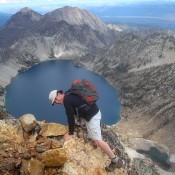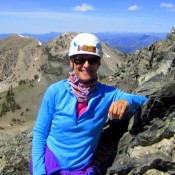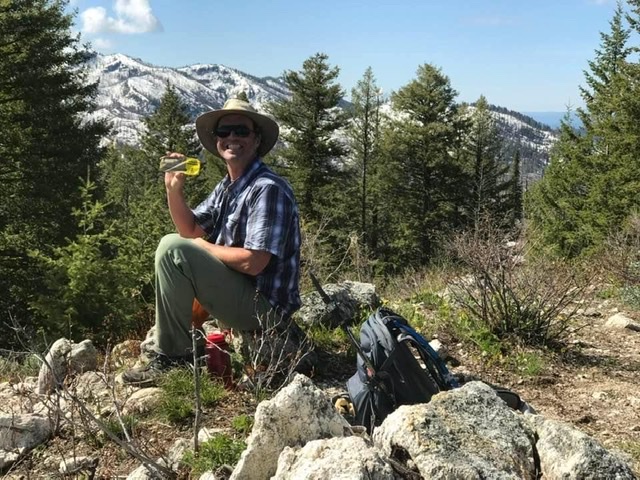| Website: idahoalpinezone.com/ |

Dave is an avid mountain climber who can’t get enough of Idaho’s mountain tops. He is an Idaho native who prides himself on the variety of Idaho peaks that he has climbed. This is evidenced by his climbing resume of over 275 Idaho peaks, spread across more than a dozen different mountain ranges. Dave is particularly fond of the White Cloud Mountains where he is the only climber known to have summitted all 50 of the peaks over 10,000 feet in elevation.
Dave has provided significant contributions to this website which can be found at the following link: Dave Pahlas Contributions
Dave also shared the following account of one of his more memorable Sawtooth experiences.
A Goal Achieved by Dave Pahlas
Mount Regan has been a long time infatuation for me. Long before the concept of mountain climbing began taking shape in my mind, Mount Regan had been calling me. The formidable North Face of Mount Regan creates an impressive backdrop above highly-scenic Sawtooth Lake. Sawtooth Lake was a favorite hiking destination in my youth and early adult years. My inaugural trip to Sawtooth Lake was made on my father’s shoulders during the Summer before my 1st birthday. The first visit under my own power was at about age 8. Many more would follow, including a couple of Boy Scout backpacking trips, hikes with family and friends and even a memorable outing with my own son on my shoulders during the Summer before his 1st birthday.
Beautiful alpine Sawtooth Lake is a popular Sawtooth day hike for good reason. Because of this popularity, Mount Regan has become one of the most photographed peaks in all of Idaho. There’s just something about the inspiring “ahhh-haaaa” view you experience as the trail crests the rocks near the outlet at the north end of Sawtooth Lake. The view of the massive alpine lake with the imposing mountain rising far above on the opposite side is nothing short of spectacular. To me, the big humbling view has a way of helping me understand how small we are in this world.
So who wouldn’t want to climb to the top of Mount Regan and look down on Sawtooth Lake to see what it looks like from above? Of course, the challenge with capturing the view is that most casual hikers are unlikely to ever reach the summit. Guarded by steep cliffs and sometimes loose rock, most routes up Mount Regan require technical climbing. The only non-technical route is the Southeast Ridge and it still involves some very exposed Class 4 moves.
It wasn’t long after I took up mountain climbing that Mount Regan moved up to the top of my wish list of summits to visit. With limited Class 4 experience, I knew that a solo climb wouldn’t be wise. So I began badgering experienced climbers to come join me for the climb. I was stoked when my friend Sean said he would accompany me. Sean is an excellent climber and a great guy. He had climbed the route before so I knew that we were in for a good day.
I could barely sleep the night before climbing Mount Regan. I was just way too wound up with the anticipation of climbing the challenging route to the summit of a peak I’d been captivated by for decades. Sean and I were on our feet and hiking from the Iron Creek trailhead by about 7:30AM. We made good time on our way up the trail. It was a nice, crisp October morning and we passed the time discussing our past climbs and the college football rankings. We made it to Sawtooth Lake in just under 3 hours and, as usual, Regan beckoned us from the far side of the lake. After another 2 miles of highly scenic hiking, we left the trail near the base of Regan’s Southeast Ridge. We contoured around to the start of the ridge through a boulder field (staying at about 8,300 feet) until we found an obvious gully. The gully is full of loose rock so we spread out to avoid kicking anything loose onto each other. We climbed until the gully became steep. Then an obvious route became apparent heading to the left. From here, we pretty much followed the ridgeline to the base of Mount Regan’s summit block.
To reach the base of the summit block, the climbing had been mostly Class 2 and there had been no technically challenging climbing up to this point. Based on our knowledge of the route, we knew that that was about to change. The summit block was pretty daunting with no obvious route. But we knew from Sean’s prior climb (and from the Tom Lopez book) that we needed to angle out onto the Northeast Face and then find our way up to the summit. My adrenaline was pumping knowing what was in store for us and the route didn’t disappoint. There was plenty of exposure but the rock was generally stable. We climbed a moderate angle face, traversed over to a gully, climbed for awhile, descended a bit and then climbed some more. After a couple tricky spots of low Class 4, we were on the home stretch once the angle eased off and were soon on the summit.
I had been looking forward to looking down on Sawtooth Lake from the summit, reversing the view I’d soaked in so many times over the years. It was an awesome feeling to be perched on this fantastic summit after the challenging scramble that brought us here. But all good things must come to an end, so after a bite to eat and numerous photos, we reluctantly began the descent. The down-climb wasn’t to be taken lightly. We took our time and carefully chose the safest route back down the face.








